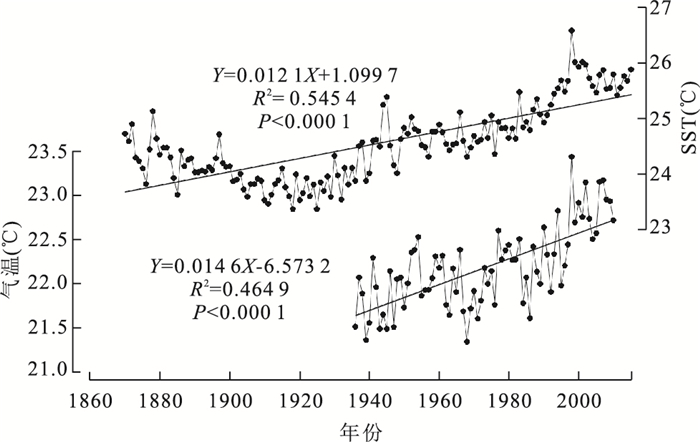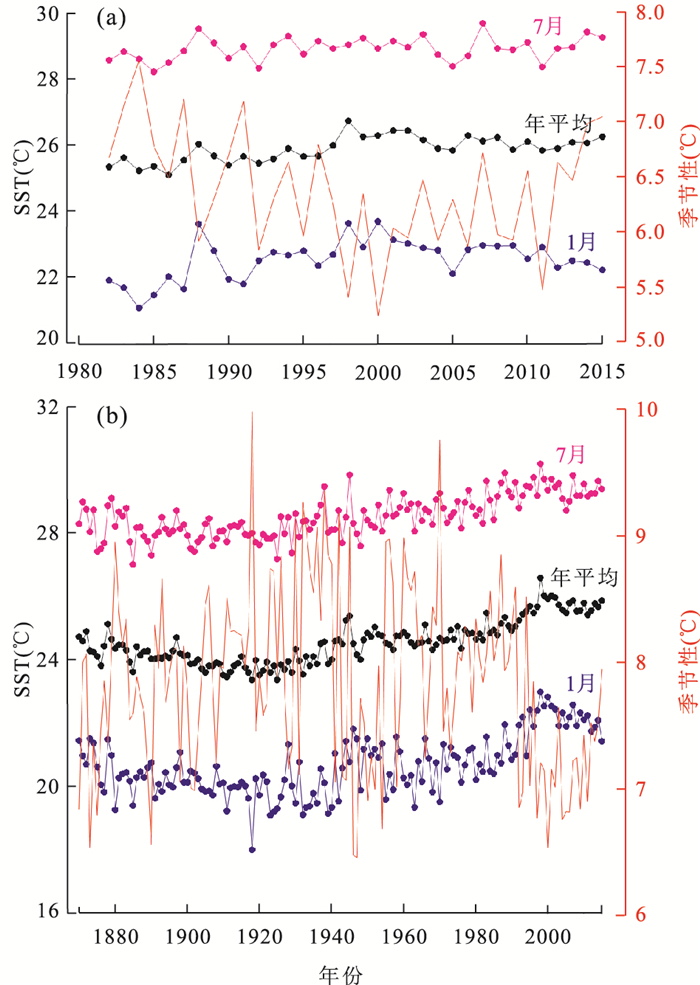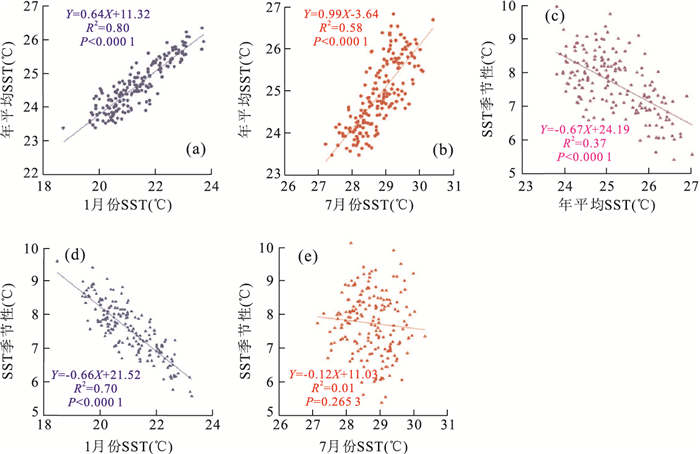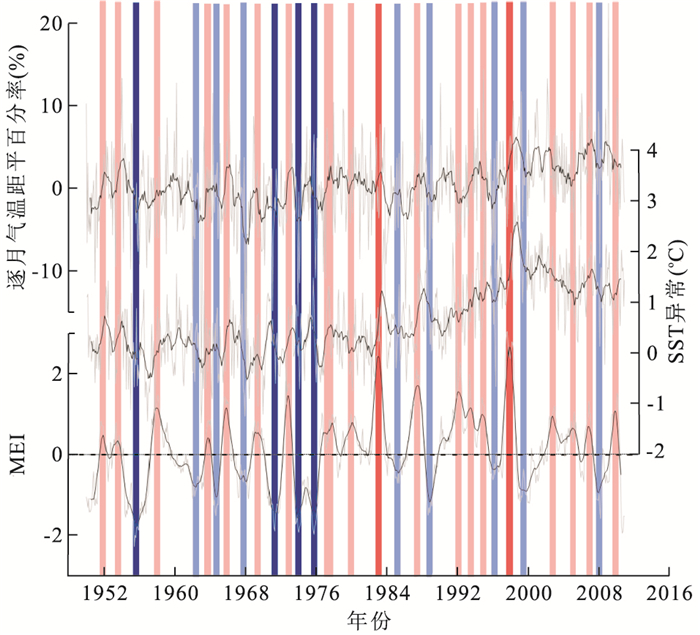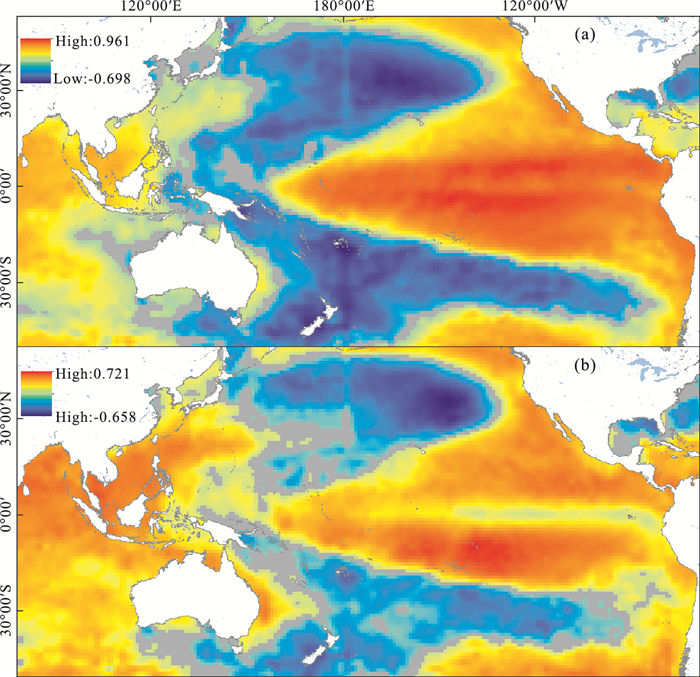Seasonal and Inter-Annual Anomalies of Sea Surface Temperature Offshore Northeastern Taiwan and Its Implication to Historical Climate Reconstructions
-
摘要: SST(海洋表层温度,sea surface temperature)的季节与年际异常对于认识现代全球变暖、重建历史时期气候变化以及探讨气候变化机制具有重要意义,而台湾东北部海域SST季节与年际异常的研究却相对较少.为更好地理解现代全球变暖和历史气候变化,利用NOAA的全球海表温度最优插值资料、Hadley中心的全球海表温度数据以及MEI逐月指数,分析了现代全球变暖背景下台湾东北部海域SST季节与年际异常及其控制因素.季节尺度上,受东亚冬季风的影响,研究海区的冬季SST变化比夏季更为剧烈,冬季SST控制着该海域年均SST和SST季节性的变化.现代器测和古气候记录表明该现象在年际-百年尺度上可能一直存在.年际尺度上,SST异常与MEI指数存在显著的8个月滞后相关性,ENSO(厄尔尼诺—南方涛动,El Niño-Southern Oscillation)事件通过东亚冬季风来影响研究海域的SST变化.在历史气候重建中区分气候变化的多尺度性和替代指标的季节性、认识历史气候对ENSO及东亚冬季风的响应特征和机制,这将有助于进一步理解现代全球气候变暖的原因.Abstract: Seasonal and inter-annual anomalies of sea surface temperature (SST) are very important for recognizing modern global warming, reconstructing historical climate changes and discussing mechanisms of climate changes. However, the related researches of SST offshore northeastern Taiwan are not enough. Based on NOAA's monthly SST data, monthly SST data from Hadley Center and monthly Multivariate ENSO Index (MEI), the seasonal and inter-annual anomalies of SST and their influencing factors offshore northeastern Taiwan under the background of modern global warming are analyzed in order to further understand modern global warming and historical climate changes. On seasonal timescales, winter SST always displays greater variation range than summer SST, and its influence on the annual mean SST and SST seasonality is more serious, which could be contributed to the effects of East Asian Winter Monsoon (EAWM). Modern instrumental data and paleoclimate records show that greater variabilities of winter SST than summer SST possibly also exist on the inter-annual-centennial timescales. On inter-annual timescales, the SST anomalies offshore northeastern Taiwan exhibit a good lag correlation to MEI Index indicating the significant effect of ENSO on SST anomalies through the robust role of EAWM. It is crucial to distinguish the different multi-scales of climate change and seasonal explanations of temperature proxies when reconstructing the past temperature variation. And, insight to the responses of historical climate to ENSO and EAWM would be helpful to further understand the cause of modern global warming.
-
0. 引言
20世纪以来的全球变暖趋势已被广泛认同(Solomon et al., 2007; Stocker et al., 2013),对现代气候增暖的历史地位和归因的准确评估,需要对过去更长时段内的气候变化历史有充分认识.过去2 000年里,地球气候的一些自然参数没有发生显著的变化,对这一时段气候变化的研究是辨识当前全球变暖的自然和人为驱动贡献的科学基础,对预估未来气候变化趋势具有重要意义.经过几十年的研究积累,有关过去2 000年全球气温变化的研究取得了突破性进展(Ahmed et al., 2013),然而各大陆的温度变化过程也显示了明显的区域特征,且由于代用指标的偏向性和公元1500年之前资料的缺乏,全球和区域规模的温度重建结果依然存在很大的不确定性(D'Arrigo et al., 2008; Mann et al., 2009; Ge et al., 2010).大量研究显示,过去2 000年全球或区域性地存在着百年尺度的温暖期,如罗马暖期(约550 BC~350 AD)和中世纪暖期(约800 AD~1 300 AD)(Lamb, 1965, 1977; Yan et al., 2011, 2015a).有关这些历史暖期在不同区域的温度变化幅度和时间跨度仍然有很大的不确定性,对于近千年以来温暖期的气候变化研究,有助于更好地认识当今气候变暖的历史地位和原因.
此外,海洋是气候系统的一个重要组成部分,在全球和区域的气候变化中, 海洋的影响至关重要,认识过去2 000年海洋的变化有助于理解现代气候变暖的本质.目前,与北半球大陆密集的古温度重建结果相比(Ahmed et al., 2013),高分辨率、长时间跨度的海洋(特别是热带、亚热带海区)温度记录的匮乏,极大地阻碍着对过去2 000年全球规模的温度变化幅度、过程和原因的评估(Cunningham et al., 2013).利用各种代用指标在特定关键海区重建近千年来海洋温盐等参数的高分辨率变化依然是过去2 000年气候研究中面临的巨大挑战.其中全球变暖背景下器测数据的挖掘对于研究历史暖期的气候变化至关重要,重建过去千年以来海洋表层温度(SST)的历史之前,理清现代区域SST(sea surface temperature)变化特征和机制是非常有必要的.
台湾东北部海域位于中国东海与菲律宾海的交界处.该区处于西北太平洋亚热带,为全球南北气流、亚洲西向季风与东向信风的一个交汇处,其气候对西北太平洋、东亚及南亚大气环流大尺度的变化十分敏感(Chou et al., 2011).同时,起源于北赤道流的黑潮沿其东侧北上,黑潮及其附近海域海温异常对全球气候有重要影响(倪东鸿等, 2003; 赵永平和McBean, 1995);黑潮流速、流量的变化不仅与北赤道流的变异密切相关,同时也受ENSO(El Niño-Southern Oscillation)活动的影响(Yamagata et al., 1985; Yasuda et al., 1985; 袁耀初等, 2001),其流经海区的温盐变化包含赤道季风、热带太平洋的信息(Wang and Ding, 2006).因此,本文选取台湾东北部海域,探讨该海区一百多年来SST季节与年际异常及其影响因素,为将来重建过去千年区域气候变化提供现代器测资料的支持.
1. 资料与方法介绍
本文所使用的台湾东北部海域(图 1)1982年1月—2015年12月逐月SST资料来自美国国家海洋和大气局(NOAA)提供的全球海表温度最优插值数据集(NOAA_OI_SST_V2),范围为24°N~25°N、122°E~123°E,水平分辨率为1°×1°(Reynolds et al., 2002);1870年1月—2015年12月逐月SST资料来自英国气象局哈德莱中心(Hadley)提供的全球海表温度数据集(HadISST1),范围为24°N~25°N、122°E~123°E,水平分辨率为1°×1°(Rayner, 2003).台湾宜兰县1936年1月—2010年12月逐月气温资料来自台湾中央气象局.ENSO资料选用美国国家海洋和大气局(NOAA)地球系统研究实验室(ESRL)公布的多变量ENSO指数,即MEI(Multivariate ENSO Index)逐月指数.该指数是基于热带太平洋6个主要观测变量(海平面气压、地表径向与纬向风、海表面温度、地球表面气温以及天空总云量),通过计算而得到的一种检测ENSO变化的指数(Wolter and Timlin, 1993, 1998).台湾东北部海域逐年SST季节性通过每年7月SST减去该年1月SST而得到(SST季节性=该年7月SST-该年1月SST);逐月SST异常通过计算Z-score而得到[Z-score=(月观测值-该月平均值)/该月标准偏差];台湾宜兰逐月气温距平百分率是在各月气温平均值的基础上计算得到,表达公式为:气温距平百分率=(月观测气温值-该月气温平均值)/该月气温平均值.利用时间序列分析软件Redfit3.8对1950—2010年MEI逐月指数和台湾东北部海域逐月SST异常进行频谱分析,提取这两个时间序列的周期信息(Schulz and Mudelsee, 2002).
2. 台湾东北部海域SST季节与年际异常及其影响因素
2.1 区域温度长期变化特征
1870—2015年台湾东北部海域年平均SST呈现出显著的上升趋势,通过了99%的置信度检验,140多年以来SST上升速率为1.21 ℃/100 a(图 2).笔者对台湾宜兰过去70多年来(1936—2010年)气温资料的分析显示:该地区年均气温也表现出了明显的上升趋势,上升速率为1.46 ℃/100 a,同样通过了99%的置信度检验(图 2),可见该区域局地气温变化趋势与海表温度具有良好的相关性.1870— 2015年台湾东北部海域SST上升速率(1.21 ℃/100 a)与1900—2008年黑潮流域百年海表变暖速率(1.29 ℃/100 a)(Wu et al., 2012a)相近,而略低于1909—2010年中国中东部百年SST上升速率(1.52 ℃/100 a)(Cao et al., 2013).此外,无论是SST还是局地气温都表现了强烈的年际波动,过去70多年以来宜兰的最高年平均气温发生在1998年,达23.43 ℃;过去100多年以来台湾东北部海域年平均SST最高值也出现在1998年,达26.58 ℃(图 2).可见,台湾东北部海域的海表温度和台湾宜兰的局地气温与全球绝大部分区域一样都显示出了20世纪以来的变暖趋势,但上升速率却表现了一定的海陆差异和区域性特征.
2.2 海表温度季节异常与东亚冬季风的联系
近30年来(1982—2015年)台湾东北部海域夏季、冬季及年均SST的变化显示,夏季SST波动较小,而冬季SST波动较大,冬季SST的变化明显比夏季更为剧烈(图 3a),该现象同样存在于近140年以来(1870—2015年)的SST变化之中(图 3b).对年平均SST分别与1月份SST、7月份SST做一元线性回归发现,1月份SST与年平均SST的相关性(R2=0.80,P<0.000 1)明显高于7月份SST(R2=0.58,P<0.000 1),说明冬季SST对年平均SST的影响比夏季更明显(图 4a,4b).同时,SST季节性分别与年平均SST、1月份SST、7月份SST的一元线性回归结果也显示,SST季节性与1月份SST具有最高的显著相关性(R2=0.70,P<0.000 1),而年平均SST和7月份SST与SST季节性的相关性或显著性都比较差,说明该地区SST季节性变化主要受冬季SST控制(图 4c~4e).
 图 4 台湾东北部海域年平均SST与1月份SST(a)、7月份SST(b)的线性回归,以及SST季节性与年平均SST(c)、1月份SST(d)、7月份SST(e)的线性回归Fig. 4. The linear regressions of annual mean SST versus January SST (a), annual mean SST versus July SST (b), SST seasonality versus annual mean SST (c), SST seasonality versus January SST (d), SST seasonality versus July SST (e) offshore northeastern Taiwan
图 4 台湾东北部海域年平均SST与1月份SST(a)、7月份SST(b)的线性回归,以及SST季节性与年平均SST(c)、1月份SST(d)、7月份SST(e)的线性回归Fig. 4. The linear regressions of annual mean SST versus January SST (a), annual mean SST versus July SST (b), SST seasonality versus annual mean SST (c), SST seasonality versus January SST (d), SST seasonality versus July SST (e) offshore northeastern Taiwan台湾东北部海域位于西太平洋暖池西北边缘,夏季暖池北移,该海域夏季SST主要受西太平洋暖池状态的控制(图 1),而暖池核心区(>29 ℃)夏季SST波动不大(Qu et al., 2005),故研究海域夏季SST波动较小.台湾东北部海域地处东亚季风控制区,东亚季风异常对中国近海海表温度异常有重要影响(Wang et al., 2002).观测资料发现,东亚冬季风异常对西北太平洋冬季SST存在显著的影响, 冬季风增强(减弱), 我国近海和黑潮流域SST下降(上升)(秦正坤和孙照渤, 2006).东亚冬季风通过调控海气热通量来影响我国东部近海SST,冬季风增强时,偏强的东亚冬季风有利于寒潮和冷涌的出现,导致冷空气频繁地影响东亚边缘海,该海域海表感热、潜热和长波辐射通量都大幅增长,海水易于散热,从而导致SST下降;冬季风减弱时, 海表感热、潜热和长波辐射通量变小,海水散热较少, 因此SST易出现升温的趋势(梁巧倩等, 2006; 秦正坤和孙照渤, 2006).此外,冬季风异常能够驱动海流并产生海流异常, 继而通过海水辐合辐散和平流导致其海温发生相应的变化(吴国雄等, 2000; 秦正坤和孙照渤, 2006).东亚冬季风是东海沿岸流冬季南下的主要驱动力,强烈的东亚冬季风必然会导致强劲的北方冷水团向南侵入(Pan et al., 2012).冬季西太平洋暖池南移,受东北向东亚冬季风驱动,东海和南海明显存在一股沿岸南下的冷水团,呈“冷舌状”(图 1).可见,台湾东北部海域冬季SST变化、年平均SST变化以及SST季节性与起源于西伯利亚高压的东亚冬季风异常有密切的关系.
2.3 海表温度年际异常与ENSO的关系
ENSO是发生在赤道中、东太平洋上复杂的大尺度海气相互作用事件,作为气候系统中仅次于季节变化的最强年际变率信号,ENSO事件通过沃克环流及哈德莱环流,对中高纬度地区的天气和气候有重大影响(Wang, 2002).为考察ENSO背景下台湾东北部海域SST异常的变化,对MEI逐月指数分别与SST逐月异常和宜兰逐月气温距平百分率做相关分析后发现,过去60年(1950—2010年)以来MEI逐月指数与两者之间相关性显著,但是相关系数较小,分别为R=0.13(P<0.001)和R=0.15(P<0.001).分别对逐月SST异常、气温距平百分率以及MEI指数做11个月的移动平滑后,相关性明显提高为R=0.23(P<0.001)和R=0.30(P<0.001).El Niño年(1951、1963、1972、1982/1983,1986/1987,1991/1992,1997/1998,2003/2004等年份)台湾东北部海域SST和宜兰气温均出现正异常(偏暖);而LaNiña年(1954/1956,1964/1966,1970/1972,1973/1975,1984/1985,1988/1989,2008/2009等年份)SST和气温则多出现负异常(偏冷),但是El Niño事件超前于该地区的温度变化(图 5).此外,11个月移动平滑后的SST异常与MEI指数的统计分析也显示出这一显著的相关性,且台湾东北部SST异常存在明显的滞后效应(图 6a).MEI指数对SST异常分别做12个月的超前和滞后相关分析,结果显示当台湾东北部SST异常比ENSO滞后8个月时,两者出现了最大的正相关,相关系数为R=0.429(P<0.001,图 6a),表明ENSO滞后8个月对台湾东北部海域SST的影响达到最大.
 图 5 1950—2010年台湾宜兰逐月气温距平百分率(上,黑线为11个月移动平均曲线)、台湾东北部海域逐月SST异常(中,黑线为11个月移动平均曲线)以及MEI逐月指数(下,黑线为11个月移动平均曲线)(深)浅红色阴影:(超强)厄尔尼诺事件;(深)浅蓝色阴影:(超强)拉尼娜事件Fig. 5. Percentage of monthly air-temperature anomalies in Yilan County, Taiwan (up, black bold line denotes 11-months moving averages), monthly SST anomalies offshore northeastern Taiwan (middle, black bold line denotes 11-months moving averages), and monthly MEI index(down, black bold line denotes 11-months moving averages) in 1950—2010
图 5 1950—2010年台湾宜兰逐月气温距平百分率(上,黑线为11个月移动平均曲线)、台湾东北部海域逐月SST异常(中,黑线为11个月移动平均曲线)以及MEI逐月指数(下,黑线为11个月移动平均曲线)(深)浅红色阴影:(超强)厄尔尼诺事件;(深)浅蓝色阴影:(超强)拉尼娜事件Fig. 5. Percentage of monthly air-temperature anomalies in Yilan County, Taiwan (up, black bold line denotes 11-months moving averages), monthly SST anomalies offshore northeastern Taiwan (middle, black bold line denotes 11-months moving averages), and monthly MEI index(down, black bold line denotes 11-months moving averages) in 1950—2010 图 6 (a) MEI与台湾东北部海域SST异常(11个月移动平均处理后)滞后相关性(粗线代表大于99%置信水平); (b)MEI指数(11个月移动平均处理后,红线)和台湾东北部海域SST异常(11个月移动平均处理后,蓝线)的频谱分析Fig. 6. (a) Lagged correlation between MEI index and SST anomalies offshore northeastern Taiwan (thick curve indicates the > 99% confidence level; 11-month moving averages has been applied); (b) Spectral analysis of MEI index(red, after 11-month moving averages) and SST anomalies (blue, after 11-month moving averages)
图 6 (a) MEI与台湾东北部海域SST异常(11个月移动平均处理后)滞后相关性(粗线代表大于99%置信水平); (b)MEI指数(11个月移动平均处理后,红线)和台湾东北部海域SST异常(11个月移动平均处理后,蓝线)的频谱分析Fig. 6. (a) Lagged correlation between MEI index and SST anomalies offshore northeastern Taiwan (thick curve indicates the > 99% confidence level; 11-month moving averages has been applied); (b) Spectral analysis of MEI index(red, after 11-month moving averages) and SST anomalies (blue, after 11-month moving averages)El Niño事件一般冬季12月份达到成熟阶段,到次年春季就开始衰退,通常情况下次年春末夏初结束,夏季赤道中东太平洋将处于偏冷状态,秋季后转为LaNiña事件的可能性大.当El Niño发生时,东太平洋温度上升,东西太平洋SST梯度降低,气压梯度也会减小,信风变弱;变弱的信风会造成上升流变弱、温跃层加深以及冷水输送变慢,东太平洋温度会进一步升高(Bjerknes, 1969).El Niño事件中,赤道中东太平洋海表温度的大范围异常直接驱动全球大气环流的异常变化(Wang, 2002).受El Niño事件的影响,El Niño发展年(中东太平洋SST异常偏暖)中国东海海温出现大范围的显著偏低现象,而El Niño衰退年东海海域海温较常年同期偏高(王智祖等, 2012).MEI指数与太平洋SST异常(11个月移动平均处理后)相关图显示,El Niño鼎盛期台湾东北部海域SST与赤道中东太平洋SST正相关关系不明显,但滞后8个月的MEI指数与太平洋SST异常相关图却显示,台湾东北部海域(甚至整个西北太平洋)SST与MEI指数的线性相关性显著升高,这说明El Niño对西北太平洋SST的影响存在明显的滞后效应(图 7).一般在次年的夏季(滞后8个月),El Niño事件对台湾东北部海域SST的影响达到最大.台湾东北部海域SST和台湾宜兰气温在1998年达到最近一百多年或几十年的最高值,而1998年正是1997/1998超强厄尔尼诺年的次年(图 2,图 5).此外,ENSO特征之一为赤道太平洋SST在年际尺度上具有显著的2~7年周期变化,与此相应1950—2010年MEI指数主要存在34、44、49、59、68、78个月的显著周期.1950—2010年逐月SST异常的频谱分析结果也得到了34、43、48、55个月的周期,且都通过了95%的置信度检验(图 6b).以上结果都表明,在年际尺度上台湾东北部海域的SST异常与ENSO有着直接的联系,El Niño发生时该海域SST异常偏暖,LaNiña发生时SST异常偏冷.
大量的研究表明ENSO事件与东亚冬季风的变化有密切联系,El Niño年东亚冬季风减弱,而LaNiña年东亚冬季风往往偏强(穆明权和李崇银, 1999; Wang et al., 2000; Jhun and Lee, 2004; 刘屹岷等, 2016).冬季El Niño盛行时,欧亚大陆大部分地区(尤其是中高纬地区)气温偏暖,导致海洋与陆地之间热力对比减弱,东亚地区出现南风异常,即冬季风偏弱.此外,与El Niño相关的西太平洋反气旋环流的西南气流,从印度洋-南海-西太平洋输送异常多的水汽到中国东部,该反气旋的存在也会减弱东亚冬季风的强度(刘屹岷等, 2016).El Niño年东北季风减弱,从大陆带来的干冷空气显著减少,导致中国沿岸浅水区域净热通量变化为正值(海洋得热增多或失热减少),温度升高(秦正坤和孙照渤, 2006).可见,台湾东北部海域SST异常与东亚冬季风和ENSO具有非常密切的联系,SST异常与ENSO指数具有显著的正相关关系(图 5,图 6),在El Niño发生时该海域偏暖,ENSO可能主要通过减弱东亚冬季风的强度使研究海域SST升高,并且表现为SST异常对ENSO指数响应的滞后.
3. 海表温度异常对历史温暖期的启示
过去2000多年来,北半球中高纬及西太平洋地区存在两个显著的温暖期,即中世纪暖期和罗马暖期(Lamb, 1965, 1977; Yan et al., 2015a).由于绝大多数高分辨率的温度替代指标(如树轮、珊瑚、石笋等)时间跨度较短而且不连续,加上热带或亚热带海区高分辨率记录的严重缺乏,导致对历史温暖期的认识非常有限.前文分析表明,现代全球变暖背景下台湾东北部海域夏季SST主要受西太平洋暖池的热动力特征影响,冬季SST主要受东亚冬季风的影响,且东亚冬季风也是影响该区域SST季节性变化的主要因素.对全球1月份与7月份SST变化幅度的分析显示,在北半球1月份SST变化幅度比7月份大的地区主要分布在冬季偏北风活动频繁的区域(除北极以外),比如中国东海、南海近岸海域和北美东部、南部近岸海域(Yan et al., 2015a).因此,对这些地区历史温暖期SST重建结果的分析,应注意冬季与夏季SST年际变化的差异.
在年际尺度上,冬季与夏季SST变化幅度的不同也表现在南海北部现代和中全新世珊瑚的氧同位素记录中(Peng et al., 2003; Sun et al., 2005),现代暖期南海北部冬季SST年际变化幅度较大,海南岛珊瑚δ18O的年际变化反映了冬季SST的年际变化,进而指示东亚冬季风强度(Peng et al., 2003).中全新世海南岛冬季珊瑚氧同位素的年际变化主要受控于冬季SST,夏季珊瑚氧同位素的年际变化主要受控于夏季降水,而受夏季SST的影响很小,这说明南海北部夏季SST相对冬季SST年际变化较小(Sun et al., 2005).在百年尺度上,过去千年SST的集成记录显示,南海北部不同冷暖期SST的季节性大小是动态变化的,寒冷期SST季节性比较大,温暖期SST季节性比较小,这主要是冬季SST变化幅度大于夏季SST变化幅度导致的(Yan et al., 2015a).南海北部高分辨率的砗磲Sr/Ca海表温度记录也显示,在罗马暖期和中世纪暖期南海北部的年均SST、夏季SST、冬季SST都分别比现代该地区的年均SST、夏季SST、冬季SST要高(Yan et al., 2014b, 2015a, 2015b),但是这两个历史暖期相对现代暖期而言冬季SST与夏季SST变暖幅度却不同.这两个历史暖期的西太平洋暖池变强(夏季SST变高),东亚冬季风变弱(冬季SST变高),但是冬季SST比夏季SST升高幅度更大,因此SST的季节性变小(Yan et al., 2015b).这说明在过去的温暖期,西太平洋暖池变化不大,东亚冬季风却显著减弱(Yan et al., 2015b),西伯利亚高压指数也显示中世纪暖期东亚冬季风明显减弱(Meeker and Mayewski, 2002).这些结果表明,南海北部的冬季SST变化幅度不仅在年际尺度上比夏季SST变化幅度要大,而且在百年尺度上这种现象可能同样存在,冬季SST变化幅度较大与东亚冬季风强弱的变化密不可分.
SST季节性大小与气候平均态的关系在阿拉伯半岛近岸海域、北美缅因湾、苏格兰东北海域也有发现(Wanamaker et al., 2011; Surge and Barrett, 2012; Naidu et al., 2014),阿拉伯半岛近岸海域的中世纪暖期冬季SST相对小冰期冬季SST的升高幅度比夏季SST的升高幅度要大,表现为中世纪暖期的季节性比较小.北美缅因湾中世纪暖期的冬季SST相对小冰期的冬季SST变暖,但是夏季SST反而变冷,表现为中世纪暖期的季节性比较小.苏格兰东北海域中世纪暖期的冬季SST相对现代暖期的冬季SST变冷,但是夏季SST反而变暖,表现为中世纪暖期的季节性比较大.可见,SST季节性大小与气候平均态的关系在不同地区是不一样的,为了更好地理解该现象,需要开展更多的高分辨率SST重建工作.在多指标气候记录的集成研究中,绝大多数的替代指标由于缺乏足够的时间分辨率而无法识别其温度的季节代表性,这些结果可能与年平均温度有很大的出入(Jansen et al., 2007; Ekaykin et al., 2014).因此,在季节性变化较大的地区,集成结果会存在很大的不确定性,比如关于20世纪是否是过去1300年以来最暖时期的争议(Jansen et al., 2007; Wu et al., 2012b; Ahmed et al., 2013; Yan et al., 2014b).过去千年全球各纬度的SST重建显示,中世纪暖期的温度与现代暖期的温度相当,甚至更高(Jacoby et al., 2004; Oppo et al., 2009; Wu et al., 2012a; Cunningham et al., 2013),但与近十年北半球大陆的古温度集成结果相矛盾(Jansen et al., 2007; Mann et al., 2008; Ahmed et al., 2013),这可能就是替代指标的季节性不明确造成的.可见,在历史气候变化研究中要区分气候变化的多尺度性和替代指标的季节性.此外,作为最近的两次历史温暖期,罗马暖期和中世纪暖期的气候经常与现代暖期的气候做对比,以辨别自然强迫与人为强迫对气候变化的相对贡献.在现代暖期,台湾东北部海域SST年际异常明显地受到ENSO影响,东亚冬季风可能是ENSO影响该海域SST的中间桥梁;而南海北部高分辨率的SST记录也指示,罗马暖期和中世纪暖期其SST存在明显ENSO周期(Yan et al., 2014a, 2016),因此,在过去千年温暖期的气候变化研究中,应注重对ENSO事件和东亚冬季风所起作用的关注.
4. 结论
利用台湾东北部海域逐月SST数据,结合逐月MEI指数资料,对现代全球变暖背景下台湾东北部海域SST季节与年际异常及其原因的分析得出以下主要结论:
(1) 台湾东北部海域SST和台湾宜兰局地气温均呈现出显著的20世纪变暖趋势,一百多年以来该海域冬季的SST波动远大于夏季,年均SST和SST季节性主要受冬季SST的影响;东亚冬季风是影响该海区冬季SST、年平均SST以及SST季节性的主要因素.
(2) 过去60年(1950—2010年)以来,El Niño年台湾东北部海域SST出现正异常(偏暖),而LaNiña年则多出现负异常(偏冷),SST异常与MEI指数之间存在明显的滞后相关性,SST异常比ENSO滞后约8个月时间.在年际尺度上,1950—2010年该海域SST异常表现了明显的ENSO周期,ENSO可能通过减弱或增强东亚冬季风来影响该海区冬季SST.
(3) 现代台湾东北部海域冬季SST年际变化幅度比夏季大的现象也存在于古气候记录中的年际-百年尺度上,但不同地区SST季节性大小与气候平均态的关系是不一样的.
-
图 4 台湾东北部海域年平均SST与1月份SST(a)、7月份SST(b)的线性回归,以及SST季节性与年平均SST(c)、1月份SST(d)、7月份SST(e)的线性回归
Fig. 4. The linear regressions of annual mean SST versus January SST (a), annual mean SST versus July SST (b), SST seasonality versus annual mean SST (c), SST seasonality versus January SST (d), SST seasonality versus July SST (e) offshore northeastern Taiwan
图 5 1950—2010年台湾宜兰逐月气温距平百分率(上,黑线为11个月移动平均曲线)、台湾东北部海域逐月SST异常(中,黑线为11个月移动平均曲线)以及MEI逐月指数(下,黑线为11个月移动平均曲线)
(深)浅红色阴影:(超强)厄尔尼诺事件;(深)浅蓝色阴影:(超强)拉尼娜事件
Fig. 5. Percentage of monthly air-temperature anomalies in Yilan County, Taiwan (up, black bold line denotes 11-months moving averages), monthly SST anomalies offshore northeastern Taiwan (middle, black bold line denotes 11-months moving averages), and monthly MEI index(down, black bold line denotes 11-months moving averages) in 1950—2010
图 6 (a) MEI与台湾东北部海域SST异常(11个月移动平均处理后)滞后相关性(粗线代表大于99%置信水平); (b)MEI指数(11个月移动平均处理后,红线)和台湾东北部海域SST异常(11个月移动平均处理后,蓝线)的频谱分析
Fig. 6. (a) Lagged correlation between MEI index and SST anomalies offshore northeastern Taiwan (thick curve indicates the > 99% confidence level; 11-month moving averages has been applied); (b) Spectral analysis of MEI index(red, after 11-month moving averages) and SST anomalies (blue, after 11-month moving averages)
-
Ahmed, M., Anchukaitis, K.J., Asrat, A., et al., 2013.Continental-Scale Temperature Variability during the Past Two Millennia.Nature Geoscience, 6(5):339-346. https://doi.org/10.1038/ngeo1797 Bjerknes, J., 1969.Atmospheric Teleconnections from the Equatorial Pacific 1.Monthly Weather Review, 97(3):163-172.https://doi.org/10.1175/1520-0493(1969)097<0163:atftep>2.3.co;2 doi: 10.1175/1520-0493(1969)097<0163:ATFTEP>2.3.CO;2 Cao, L.J., Zhao, P., Yan, Z.W., et al., 2013.Instrumental Temperature Series in Eastern and Central China Back to the Nineteenth Century.Journal of Geophysical Research:Atmospheres, 118(15):8197-8207. https://doi.org/10.1002/jgrd.50615 Chou, M.D., Wu, C.H., Kau, W.S., 2011.Large-Scale Control of Summer Precipitation in Taiwan.Journal of Climate, 24(19):5081-5093.https://doi.org/10.1175/2011jcli4057.1 doi: 10.1175/2011JCLI4057.1 Cunningham, L.K., Austin, W.E., Knudsen, K.L., et al., 2013.Reconstructions of Surface Ocean Conditions from the Northeast Atlantic and Nordic Seas during the Last Millennium.the Holocene, 23(7):921-935. https://doi.org/10.1177/0959683613479677 d'Arrigo, R., Wilson, R., Tudhope, A., 2008.The Impact of Volcanic Forcing on Tropical Temperatures during the Past Four Centuries.Nature Geoscience, 2(1):51-56. https://doi.org/10.1038/ngeo393 Ekaykin, A.A., Kozachek, A.V., Lipenkov, V.Y., et al., 2014.Multiple Climate Shifts in the Southern Hemisphere over the Past Three Centuries Based on Central Antarctic Snow Pits and Core Studies.Annals of Glaciology, 55(66):259-266.https://doi.org/10.3189/2014aog66a189 doi: 10.3189/2014AoG66A189 Ge, Q.S., Zheng, J.Y., Hao, Z.X., et al., 2010.Temperature Variation through 2000 Years in China:An Uncertainty Analysis of Reconstruction and Regional Difference.Geophysical Research Letters, 37(3):93-101. https://doi.org/10.1029/2009gl041281 Jacoby, G., Solomina, O., Frank, D., et al., 2004.Kunashir (Kuriles) Oak 400-Years Reconstruction of Temperature and Relation to the Pacific Decadal Oscillation.Palaeogeography, Palaeoclimatology, Palaeoecology, 209(1-4):303-311. https://doi.org/10.1016/j.palaeo.2004.02.015 Jansen, E., Overpeck, J., Briffa, K.R., et al., 2007.Palaeoclimate.In:Climate Change 2007:The Physical Science Basis.Contribution of Working Group Ⅰ to the Fourth Assessment Report of the Intergovernmental Panel on Climate Change.Cambridge University Press, Cambridge, United Kingdom and New York, New York, 434-497. Jhun, J.G., Lee, E.J., 2004.A New East Asian Winter Monsoon Index and Associated Characteristics of the Winter Monsoon.Journal of Climate, 17(4):711-726.https://doi.org/10.1175/1520-0442(2004)017<0711:aneawm>2.0.co;2 doi: 10.1175/1520-0442(2004)017<0711:ANEAWM>2.0.CO;2 Lamb, H.H., 1965.The Early Medieval Warm Epoch and Its Sequel.Palaeogeography, Palaeoclimatology, Palaeoecology, 1:13-37. https://doi.org/10.1016/0031-0182(65)90004-0 Lamb, H.H., 1977.Climate:Present, Past and Future.Methuen, London. Liang, Q.Q., Jian, M.Q., Peng, Y.G., et al., 2006.Impacts of East Asian Winter Monsoon on Sea Surface Temperature in Northwestern Pacific.Journal of Tropical Oceanography, 25(6):1-7 (in Chinese with English abstract). Liu, Y.M., Liu, B.Q., Ren, R.C., et al., 2016.Current Super El Niño Event and Its Impacts on Climate in China in Spring and Summer.Bulletin of Chinese Academy of Sciences, 31(2):241-250(in Chinese with English abstract). https://www.pmel.noaa.gov/elnino/impacts-of-el-nino Mann, M.E., Zhang, Z., Hughes, M.K., et al., 2008.Proxy-Based Reconstructions of Hemispheric and Global Surface Temperature Variations over the Past Two Millennia.Proceedings of the National Academy of Sciences, 105(36):13252-13257. https://doi.org/10.1073/pnas.0805721105 Mann, M.E., Zhang, Z., Rutherford, S., et al., 2009.Global Signatures and Dynamical Origins of the Little Ice Age and Medieval Climate Anomaly.Science, 326(5957):1256-1260. https://doi.org/10.1126/science.1177303 Meeker, L.D., Mayewski, P.A., 2002.A 1400-Year High-Resolution Record of Atmospheric Circulation over the North Atlantic and Asia.The Holocene, 12(3):257-266. https://doi.org/10.1191/0959683602hl542ft Mu, M.Q., Li, C.Y., 1999.ENSO Signals in the Interannual Variability of East-Asian Winter Monsoon.Part Ⅰ:Observed Data Analyses.Chinese Journal of Atmospherica Sciences, 23(3):276-285 (in Chinese with English abstract). Naidu, P.D., Niitsuma, N., Naik, S., 2014.Oxygen Isotopic Analyses of Individual Planktic Foraminifera Species:Implications for Seasonality in the Western Arabian Sea.Climate of the Past Discussions, 10(5):3661-3688. https://doi.org/10.5194/cpd-10-3661-2014 Ni, D.H., Sun, Z.B., Chen, H.S., et al., 2003.Spatial/Temporal Features of SSTA in Kuroshio Current Region and Its Relations to General Circulation.Journal of Nanjing Institute of Meteorology, 26(6):740-748(in Chinese with English abstract). Oppo, D.W., Rosenthal, Y., Linsley, B.K., 2009.2 000-Year-Long Temperature and Hydrology Reconstructions from the Indo-Pacific Warm Pool.Nature, 460(7259):1113-1116. https://doi.org/10.1038/nature08233 Pan, A.J., Wan, X.F., Guo, X.G., et al., 2012.Responses of the Zhe-Min Coastal Current Adjacent to Pingtan Island to the Wintertime Monsoon Relaxation in 2006 and Its Mechanism.Science China Earth Sciences, 56(3):386-396. https://doi.org/10.1007/s11430-012-4429-9 Peng, Z.C., Chen, T.G., Nie, B.F., et al., 2003.Coral δ18O Records as an Indicator of Winter Monsoon Intensity in the South China Sea.Quaternary Research, 59(3):285-292.https://doi.org/10.1016/s0033-5894(03)00042-5 doi: 10.1016/S0033-5894(03)00042-5 Qin, Z.K., Sun, Z.B., 2006.Influence of Abnormal East Asian Winter Monsoon on the Northwestern Pacific Sea Temperature.Chinese Journal of Atmospheric Sciences, 30(2):257-267(in Chinese with English abstract). Qu, T.D., Du, Y., Stachan, J., et al., 2005.Sea Surface Temperature and Its Variability in the Indonesian Region.Oceanography, 18(4):50-61. https://doi.org/10.5670/oceanog.2005.05 Rayner, N.A., 2003.Global Analyses of Sea Surface Temperature, Sea Ice, and Night Marine Air Temperature since the Late Nineteenth Century.Journal of Geophysical Research, 108(D14):1-29. https://doi.org/10.1029/2002jd002670 Reynolds, R.W., Rayner, N.A., Smith, T.M., et al., 2002.An Improved In-Situ and Satellite SST Analysis for Climate.Journal of Climate, 15(13):1609-1625.https://doi.org/10.1175/1520-0442(2002)015<1609:aiisas>2.0.co;2 doi: 10.1175/1520-0442(2002)015<1609:AIISAS>2.0.CO;2 Schulz, M., Mudelsee, M., 2002.REDFIT:Estimating Red-Noise Spectra Directly from Unevenly Spaced Paleoclimatic Time Series.Computers & Geosciences, 28(3):421-426. https://doi.org/10.1016/s0098-3004(01)00044-9 Solomon, S., Qin, D., Manning, M., et al., 2007.IPCC, 2007.In:Climate Change 2007:The Physical Science Basis.Contribution of Working Group Ⅰ to the Fourth Assessment Report of the Intergovernmental Panel on Climate Change.Cambridge University Press, Cambridge, United Kingdom and New York, New York. Stocker, T.F., Qin, D., Plattner, G.K., et al., 2013.IPCC, 2013.In:Climate Change 2013:The Physical Science Basis.Contribution of Working Group Ⅰ to the Fifth Assessment Report of the Intergovernmental Panel on Climate Change.Cambridge University Press, Cambridge, United Kingdom and New York, New York, USA. Sun, D.H., Gagan, M.K., Cheng, H., et al., 2005.Seasonal and Interannual Variability of the Mid-Holocene East Asian Monsoon in Coral δ18O Records from the South China Sea.Earth and Planetary Science Letters, 237(1-2):69-84. https://doi.org/10.1016/j.epsl.2005.06.022 Surge, D., Barrett, J.H., 2012.Marine Climatic Seasonality during Medieval Times (10th to 12th Centuries) Based on Isotopic Records in Viking Age Shells from Orkney, Scotland.Palaeogeography, Palaeoclimatology, Palaeoecology, 350-352:236-246. https://doi.org/10.1016/j.palaeo.2012.07.003 Wanamaker, A.D., Kreutz, K.J., Schöne, B.R., et al., 2011.Gulf of Maine Shells Reveal Changes in Seawater Temperature Seasonality during the Medieval Climate Anomaly and the Little Ice Age.Palaeogeography, Palaeoclimatology, Palaeoecology, 302(1-2):43-51. https://doi.org/10.1016/j.palaeo.2010.06.005 Wang, B., Ding, Q.H., 2006.Changes in Global Monsoon Precipitation over the Past 56 Years.Geophysical Research Letters, 33(6):272-288. https://doi.org/10.1029/2005gl025347 Wang, B., Wu, R.G., Fu, X., 2000.Pacific-East Asian Teleconnection:How does ENSO Affect East Asian Climate? Journal of Climate, 13(9):1517-1536.https://doi.org/10.1175/1520-0442(2000)013<1517:peathd>2.0.co;2 doi: 10.1175/1520-0442(2000)013<1517:PEATHD>2.0.CO;2 Wang, C.Z., 2002.Atmospheric Circulation Cells Associated with the El Niño-Southern Oscillation.Journal of Climate, 15(4):399-419.https://doi.org/10.1175/1520-0442(2002)015<0399:accawt>2.0.co;2 doi: 10.1175/1520-0442(2002)015<0399:ACCAWT>2.0.CO;2 Wang, D.X., Xie, Q., Du, Y., et al., 2002.The 1997-1998 Warm Event in the South China Sea.Chinese Science Bulletin, 47(14):1221-1227. https://doi.org/10.1007/bf02907614 Wang, Z.Z., Zuo, J.C., Chen, M.X., et al., 2012.Relationship between El Niño and Sea Surface Temperature Variation in Coastal Region of Yellow Sea and East China Sea.Journal of Hohai University(Natural Sciences), 40(4):461-468(in Chinese with English abstract). Wolter, K., Timlin, M.S., 1993.Monitoring ENSO in COADS with a Seasonally Adjusted Principal Component Index.In:17th Climate Diagnostics Workshop, NOAA/NMC/CAC, NSSL, Oklahoma Clim.Survey, CIMMS and the School of Meteor., Univ.of Oklahoma, Norman, 52-57. Wolter, K., Timlin, M.S., 1998.Measuring the Strength of ENSO Events:How does 1997/98 Rank? Weather, 53(9):315-324.https://doi.org/10.1002/j.1477-8696.1998.tb06408.x doi: 10.1002/wea.1998.53.issue-9 Wu, G.X., Wei, Y., Liu, H., 2000.Impacts of Persistently Strong Asian Winter Monsoon on Equatorial Sea Surface Temperature Anomaly as Simulated in Climate Model.Acta Meteorologica Sinica, 58(6):641-652(in Chinese with English abstract). http://www.cmsjournal.net/qxxb_cn/ch/reader/view_abstract.aspx?doi=10.11676/qxxb2000.066 Wu, L.X., Cai, W.J., Zhang, L.P., et al., 2012a.Enhanced Warming over the Global Subtropical Western Boundary Currents.Nature Climate Change, 2(3):161-166. https://doi.org/10.1038/nclimate1353 Wu, W.C., Tan, W.B., Zhou, L.P., et al., 2012b.Sea Surface Temperature Variability in Southern Okinawa Trough during Last 2 700 Years.Geophysical Research Letters, 39(14):36-57. https://doi.org/10.1029/2012gl052749 Yamagata, T., Shibao, Y., Umatanit, S.I., 1985.Interannual Variability of the Kuroshio Extension and Its Relation to the Southern Oscillation/El Niño.Journal of the Oceanographical Society of Japan, 41(4):274-281.https://doi.org/10.1007/bf02109276 doi: 10.1007/BF02109276 Yan, H., Liu, C., Zhang, W., et al., 2016.ENSO Variability around 2 000 Years Ago Recorded by Tridacna Gigas δ18O from the South China Sea.Quaternary International, https://doi.org/10.1016/j.quaint.2016.05.011 Yan, H., Soon, W., Wang, Y.H., 2015a.A Composite Sea Surface Temperature Record of the Northern South China Sea for the Past 2 500 Years:A Unique Look into Seasonality and Seasonal Climate Changes during Warm and Cold Periods.Earth-Science Reviews, 141:122-135. https://doi.org/10.1016/j.earscirev.2014.12.003 Yan, H., Sun, L.G., Shao, D., et al., 2015b.Seawater Temperature Seasonality in the South China Sea during the Late Holocene Derived from High-Resolution Sr/Ca Ratios of Tridacna Gigas.Quaternary Research, 83(2):298-306. https://doi.org/10.1016/j.yqres.2014.12.001 Yan, H., Sun, L.G., Shao, D., et al., 2014a.Higher Sea Surface Temperature in the Northern South China Sea during the Natural Warm Periods of Late Holocene than Recent Decades.Chinese Science Bulletin, 59(31):4115-4122. https://doi.org/10.1007/s11434-014-0317-3 Yan, H., Wang, Y.H., Sun, L.G., 2014b.High Resolution Oxygen Isotope and Grayscale Records of a Medieval Fossil Giant Clam (Tridacna Gigas) in the South China Sea:Physiological and Paleoclimatic Implications.Acta Oceanologica Sinica, 33(8):18-25. https://doi.org/10.1007/s13131-014-0399-4 Yan, H., Sun, L.G., Wang, Y.H., et al., 2011.A Record of the Southern Oscillation Index for the Past 2 000 Years from Precipitation Proxies.Nature Geoscience, 4(9):611-614. https://doi.org/10.1038/ngeo1231 Yasuda, L., Yoon, J.H., Suginohara, N., 1985.Dynamics of the Kuroshio Large Meander-Barotropic Model.Journal of the Oceanographical Society of Japan, 41:259-273. doi: 10.1007/BF02109275 Yuan, Y.C., Liu, Y.G., Su, J.L., 2001.Variability of the Kuroshio In the East China Sea during El Niño to La Niña Phenomenon of 1997 and 1998.Chinese Journal of Geophysics, 44(2):199-210 (in Chinese with English abstract). https://www.sciencedirect.com/science/article/pii/S1674237015301939 Zhao, Y.P., McBean, G.A., 1995.Air-Sea Interaction between the Kuroshio Region Marine Heating Anomaly and Northern Hemisphere Atmospheric Circulation.Oceanologia et Limnologia Sinica, 26(4):383-388(in Chinese with English abstract). http://en.cnki.com.cn/Article_en/CJFDTOTAL-HKJK199600002.htm 梁巧倩, 简茂球, 彭勇刚, 等, 2006.东亚冬季风异常对西北太平洋海温的影响.热带海洋学报, 25(6):1-7. http://www.wanfangdata.com.cn/details/detail.do?_type=perio&id=rdhy200606001 刘屹岷, 刘伯奇, 任荣彩, 等, 2016.当前重大厄尔尼诺事件对我国春夏气候的影响.中国科学院院刊, 31(2):241-250. http://or.nsfc.gov.cn/bitstream/00001903-5/250270/1/1000015220581.pdf 穆明权, 李崇银, 1999.东亚冬季风年际变化的ENSO信息:Ⅰ.观测资料分析.大气科学, 23(3):276-285. http://www.cnki.com.cn/Article/CJFDTOTAL-QHYH902.004.htm 倪东鸿, 孙照渤, 陈海山, 等, 2003.冬季黑潮区域SSTA的时空演变及其与大气环流的联系.南京气象学院学报, 26(6):740-748. http://www.cqvip.com/QK/91555X/200306/9014452.html 秦正坤, 孙照渤, 2006.冬季风异常对西北太平洋海温影响的区域性特征.大气科学, 30(2):257-267. http://www.wanfangdata.com.cn/details/detail.do?_type=degree&id=Y588425 王智祖, 左军成, 陈美香, 等, 2012.黄、东海沿岸海表温度变化与厄尔尼诺的关系.河海大学学报, 40(4):461-468. https://www.wenkuxiazai.com/doc/b876dfa05022aaea988f0f47.html 吴国雄, 尉艺, 刘辉, 2000.东亚持续强冬季风影响赤道海表温度初始异常的数值试验研究.气象学报, 58(6):641-652. doi: 10.11676/qxxb2000.066 袁耀初, 刘勇刚, 苏纪兰, 2001.1997-1998年El-Nino至La-Nina期间东海黑潮的变异.地球物理学报, 44(2):199-210. http://cpfd.cnki.com.cn/Article/CPFDTOTAL-EGVE200008001001.htm 赵永平, McBean, G.A., 1995.黑潮海域海洋异常加热与北半球大气环流的相互作用.海洋与湖沼, 26(4):383-388. http://www.cqvip.com/qk/90072X/199504/1765599.html 期刊类型引用(2)
1. 钱芳,常凤鸣,孙晗杰,李铁刚,李安春,王佳. 末次冰消期冲绳海槽中部表层和温跃层海水温度演化的脱耦现象. 地球科学. 2022(07): 2602-2615 .  本站查看
本站查看2. 崔利芳,王伦澈,屈赛,邓利欢,王兆夺. 气温、降水量和人类活动对长江流域植被NDVI的影响. 地球科学. 2020(06): 1905-1917 .  本站查看
本站查看其他类型引用(0)
-











 下载:
下载:



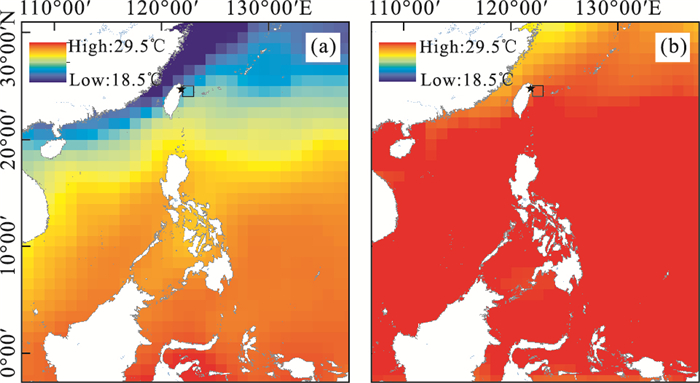
 下载:
下载:
